
The Big Dipper in Ursa Major houses a famous double star that ancient Arabic texts refer to as a visual test. Just at the kink in the Dipper’s handle is bright Mizar, with dimmer Alcor 12' to its east-northeast (upper left in this image).
Viewing double stars is a popular activity at star parties. The presenter will usually point out Mizar and its dimmer companion, Alcor, in the bend of the Big Dipper’s handle; or, in summer, telescopes are often turned to Albireo in Cygnus, to everyone’s delight.
But double stars are often neglected by today’s serious amateur observers, who are more interested in deep-sky objects. It’s a shame, because not only are double stars beautiful, but they are also a challenge by which to measure the skill of the observer and the quality of their telescope. Double stars were once the focus of both professional and amateur observers alike, and they have played an important role in our understanding of gravity and of the galaxy in which we live.
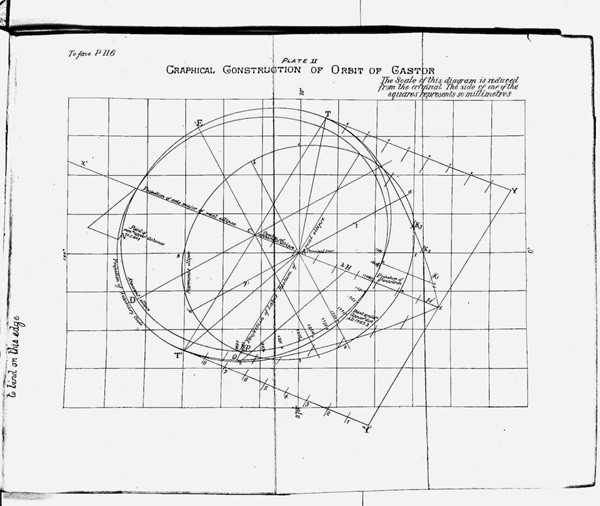
Mizar (right) is itself a binary star, with its two components 14" apart. Alcor, visible at left, is not in a system with Mizar, although the two share the same proper motion.
Seeing double
Mizar and Alcor have long been a test for good eyesight. Called the horse and rider, these stars (and hence the ability to separate them) are even referred to early Arabic texts as “the test.” But skywatchers had no idea that they were seeing just a chance alignment. Mizar and Alcor now appear to be part of a group of stars moving together through the galaxy, but they are not a true binary system bound by gravity. They are instead called a common proper motion pair.
Perfect eyesight not required
Presenters at star parties often say that in ancient times, the ability to see both Mizar and Alcor would qualify you for the Roman army. I have searched Roman literature by Cicero, Pliny the Elder, Seneca, and, most importantly, De Re Militari by Vegetius. There is no mention of any such test of eyesight either for foot soldiers or archers. Early Arabic literature does mention Alcor as a test for visual acuity, but as far as the Romans were concerned, if you could pick up a sword and shield, they signed you up for active duty. — R.S.
Less than 10 years after Galileo turned his telescope to the sky, his friend Benedetto Castelli discovered that Mizar has a nearby companion — Mizar B — of almost equal brightness. Mizar is easy to split in a small telescope. Castelli also noted the nearby companion of Beta (β) Scorpii, another favorite for small telescopes. In the mid-17th century, the English scientist Robert Hooke split Gamma (γ) Arietis in the Ram. Yet none of these observers could determine whether the stars were physically related.
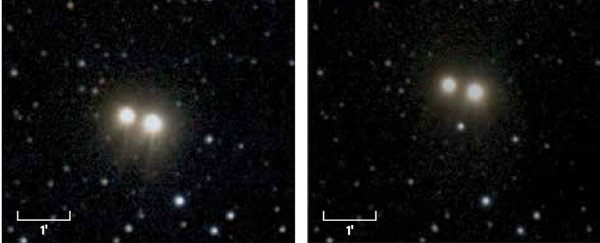
This meticulously hand-drawn diagram from Edward Crossley’s A Handbook of Double Stars shows the orbits of Castor A and B.
In 1849, Sir John Herschel wrote in his book Outlines of Astronomy, “Many of the stars, when examined with a telescope, are found to be double. … This might be attributed to accidental proximity, did it occur only in a few instances.” He goes on to write that “the frequency of this companionship [and] the extreme closeness,” means many must be physically related.
Anyone who has swept a star-filled sky with binoculars or a small telescope has seen the profusion of what appear to be closely related stars. But the true relationship of double stars is more complex than Herschel’s straightforward statement. If you have a modest backyard telescope, you can follow the trail that led to our understanding of the true nature of double stars.
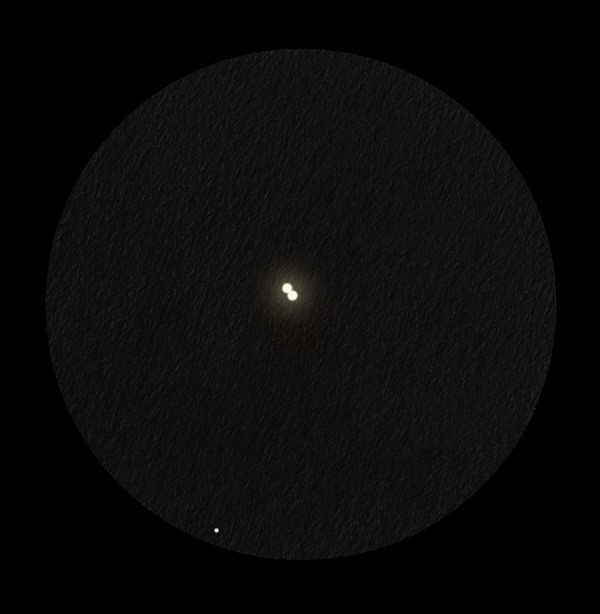
61 Cygni is known as the Flying Star for its rapid motion against the background stars. These images, taken eight years apart, show the pair’s displacement over time.
Follow the stars
Let’s start in the constellation Cygnus. The Swan is full of wonderful objects, including two fascinating double stars. One is 61 Cygni, an easy target for a small telescope. To find it, draw a line from the tail of the Swan, Deneb, to the tip of its right wing, Zeta (ζ) Cygni. 61 Cygni lies about halfway between these two stars. You will need a dark sky to see the primary, at magnitude 5.2, with the unaided eye. A good pair of binoculars will split the two widely separated stars. The companion shines at about 6th magnitude.
In 1804, the astronomer priest Giuseppe Piazzi showed, based on repeated observations, that 61 Cygni was moving noticeably against the background of the other stars in the Swan. Because of its high proper motion, he christened it the Flying Star. Three decades later, Friedrich Bessel reasoned that 61 Cygni must be relatively close to Earth. After years of observations, he was able to make the first measurement of stellar parallax, using the double star’s motion against the more distant, stationary background to determine it is only 10.4 light-years away. Modern observations place it just 1 light-year farther.
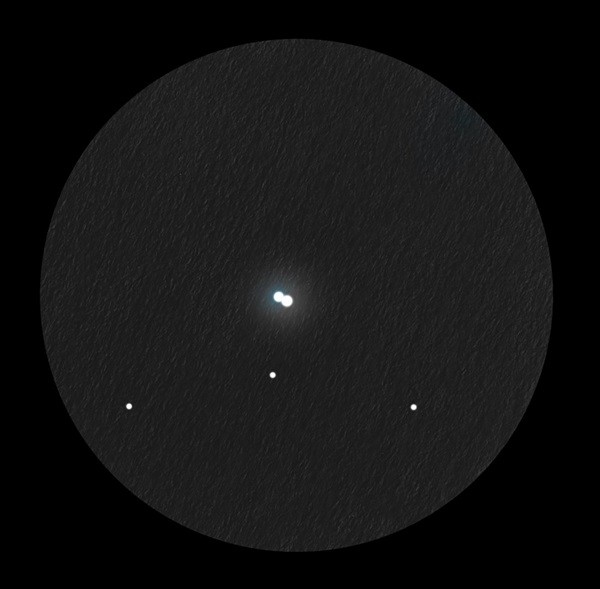
A sketch made with a 6-inch f/8 Newtonian scope resolves the two stars that make up Porrima in Virgo the Maiden.
Next, let’s move on to Virgo. The Maiden looks like a giant letter Y. Gamma Virginis, also known as Porrima, is the star at the joint of this Y. On a spring night, turn a telescope on Gamma; the two stars of this system are almost equally bright at magnitude 3.65 and 3.56. They look like two tiny headlights in space.
This particular double star helped confirm the universal nature of Newton’s theory of gravity. Early 19th-century astronomers, including Herschel, spent years refining their observations of this fascinating star system. The two stars have an orbital period of almost 169 years. At their greatest angular separation, they are nearly 6" apart. At their closest, they become difficult to split in a large-aperture telescope. This disappearing act occurred in 1836, and by charting the stars’ motions, astronomers proved they were orbiting each other according to Newton’s law of gravity. This, in turn, showed gravity not only works in our solar system with the Sun, the Moon, the planets, and other small bodies, but also in the depths of interstellar space!
Castor is Gemini’s alpha star and garnered the attention of both William and John Herschel. This sketch shows the system’s two brightest stars through an 8-inch f/6 Newtonian at 240x.
The stars again came closest in 2005. Currently, they are approaching 3" in separation, making them fairly easy to split with a small telescope. As a bonus for observers, Porrima lies less than 3° above the ecliptic and is occasionally occulted by the Moon.
The winter sky gleams with bright jewels, and one of the best is Castor in Gemini the Twins. At magnitude 1.9, Castor is the 25th-brightest star in the sky. It is also a fascinating multiple-star system. Through a modest-sized telescope, Castor is relatively easy to split into two stars, with the companion shining at magnitude 2.97 about 5" from the primary.

Although this wide-field view of Delphinus doesn’t split Gamma (upper left), the star does appear slightly greenish.
Sir William Herschel was the first astronomer to systematically study double stars. When he started his work in 1800, he “resolved to examine every star in the heavens with the utmost attention” — a monumental challenge for any observer. After several years observing Castor and its companion, Herschel was convinced the pair was a true binary star system and not a chance alignment.
This was later confirmed by John Herschel, William’s son. John continued his father’s studies of Castor, and gathered observations taken by other astronomers over the previous 100 years. These allowed him to produce detailed elements of the stars’ orbits, making this the first confirmed binary. We now know that Castor is even more complex than the Herschels could have imagined, with a total of six stars locked in mutual orbits.
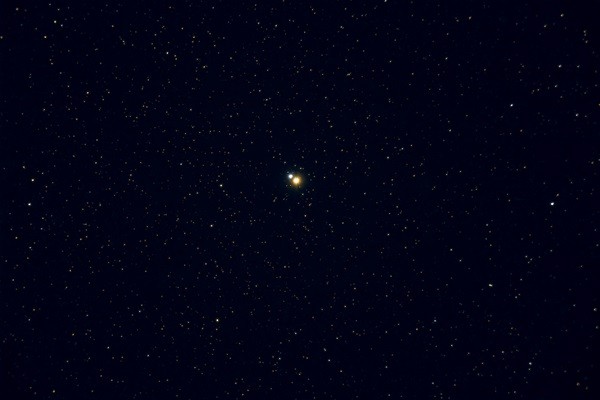
One of the sky’s most stunning double stars is Albireo, whose components are brilliant sapphire and yellow.
Color vision
The night sky is punctuated with stars that present both vivid and subtle hues. It’s easier to see these incredible colors on display in double stars because their proximity makes them easy to compare. During the 19th century, avid double-star observers reported an amazing range of colors among paired stars. Astronomer Joel Dorman Steele wrote, “Every tint that blooms in the flowers of summer, flames out in the stars at night.”
Bear in mind, though, that humans see the full range of color best in bright sunlight. The ability decreases as the light level drops. In the dark, we are more sensitive to blues and greens. This certainly affects the way we see color in stars through a telescope.
Gleaming yellow and amber in the head of Cygnus is the constellation’s other famous pair: Albireo, the crown jewel of double stars. Turn a small telescope on this star and it will resolve into a golden primary (Albireo A) and a brilliant sapphire blue companion (Albireo B). Some observers see a hint of green in the fainter star. This may be an effect of the contrast between the two stars, whose amazing colors arise from their physical properties. Albireo A is a giant more than 14 times the mass of the Sun, producing light in the yellow-orange part of the spectrum. Its companion is younger and only about four times the mass of our Sun; it shines with intensely blue-white light.
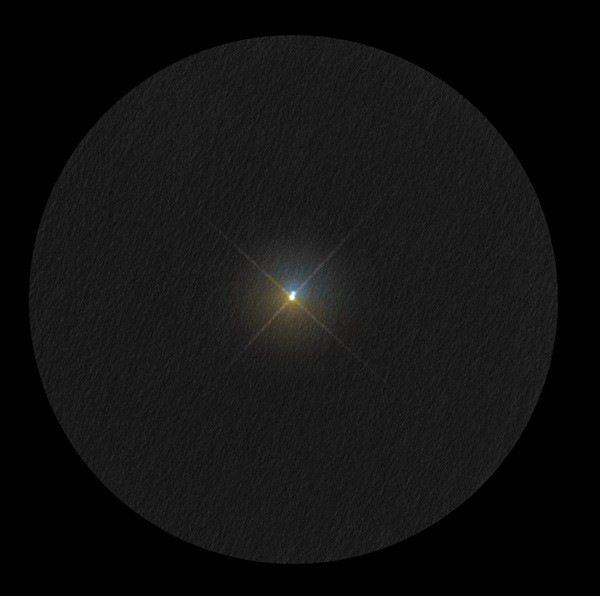
Izar in Boötes shows off its colorful components in this 2012 sketch made through a 6-inch 6/8 Newtonian scope.
Astronomers long wondered whether these two stars were physically related. In the last few years, the European Space Agency’s Gaia spacecraft has provided data suggesting this is an optical double, also known as a line-of-sight double. Regardless, the close visual effect is spectacular and Albireo is always a favorite object for viewing.
But perhaps aiming to take Albireo’s spot is Izar (Epsilon [ε] Boötis), also known as Pulcherrima, Latin for “the most beautiful.” That name was bestowed by Friedrich Georg Wilhelm von Struve, who split the star into two colorful companions using the Great Dorpat Refractor in Estonia. He said the primary was gold and the secondary an appealing blue. Other observers claim the stars look yellow and green, respectively. Epsilon can be difficult to separate with a small telescope but is well worth the effort.
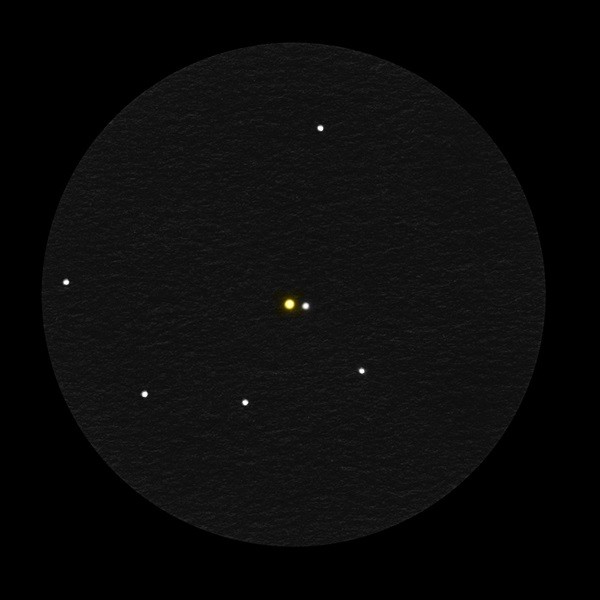
This sketch, made with a 6-inch f/8 Newtonian telescope at 240x magnification, splits Gamma Delphini into two stars.
Yet another crown jewel of the sky, Gamma Delphini is located in the constellation Delphinus’ Job’s Coffin asterism. An easy double to split, observers describe it as having unusual colors. Nineteenth-century observer Admiral William Henry Smyth called it a “beautiful double star” and said the two stars appear yellow and light emerald. Others have said they’re orange and lime. What do you see?
Seeing clearly
Throughout the 19th century and well into the 20th, both professional and amateur astronomers preferred refracting telescopes. Refractors offer a clear aperture free of the distortion and diffraction caused by the secondary mirror in reflecting telescopes. But two drawbacks of early refractors were their long focal length and their chromatic aberration, which cause poor images and color distortion, respectively. The development of achromatic and apochromatic lens systems has eliminated these issues. I currently observe double stars with both a 6-inch Celestron refractor and an 8-inch Celestron NexStar Evolution HD reflector. Both scopes provide excellent images, as will many others. Even a good pair of binoculars can provide enjoyable viewing of wide double stars. — R.S.
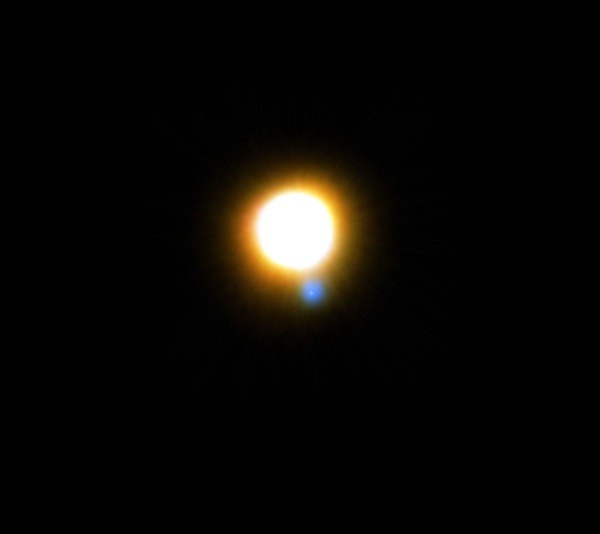
This highly magnified shot shows Antares’ much smaller close companion, Antares B.
One of the most glorious stars in the sky is Antares, the heart of the Scorpion. The name means “rival of Mars.” And anyone who has scanned the summer sky knows that Antares has a distinct red hue. At a distance of 550 light-years, this star is a nearby red supergiant.
In 1844, Scottish astronomer James W. Grant observed a companion star near Antares. The secondary star was seen again in 1846 by American astronomer Ormsby M. Mitchel. The two stars are separated by 2.5" and their colors have been described as fiery red and green or blue. The prolific English astronomer the Rev. Thomas W. Webb said that the companion appeared “yellow, with flashes of deep crimson alternating with a less proportion of fine green.” Antares is so bright that the fainter star can be overwhelmed by its glare, making this delightful double star a challenge to split, depending on the telescope and sky conditions.
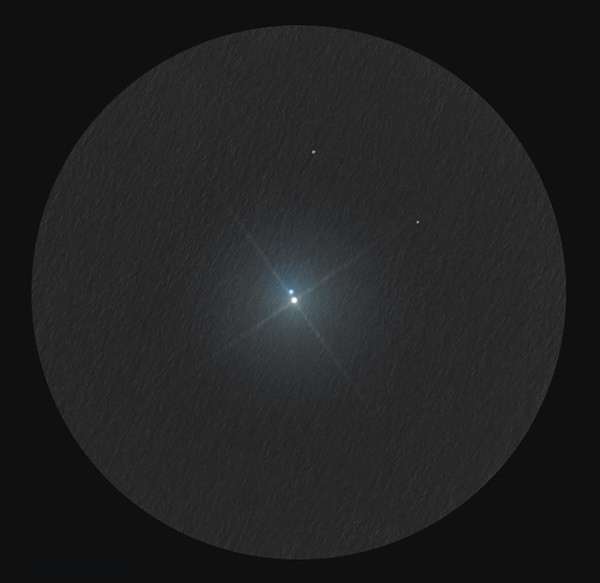
This sketch of Beta Scorpii, made with an 8-inch f/5.9 Newtonian telescope, shows the white primary accompanied by a secondary that appeared blue to the observer.
Also in Scorpius, Acrab (Beta Scorpii) at the root of the Scorpion’s uppermost claw is yet another colored double star. With a separation of more than 13", this system resolves into two stars at relatively low power. Beta appears truly white, while the second star has been called lilac or green. The discrepancy may be due to contrast between the two stars. Like Porrima, Acrab lies on the ecliptic and is occasionally occulted by the Moon.
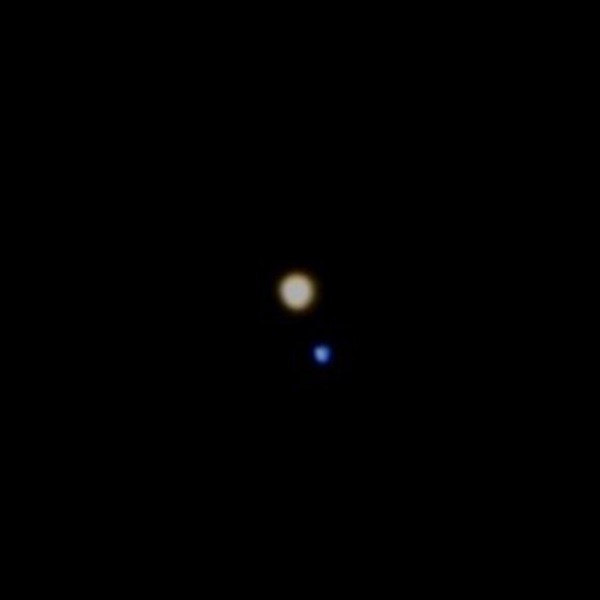
Almach, located in the foot of Andromeda, has a small companion that may appear either green or blue, depending on your color perception.
Our final destination is the left foot of the Princess Andromeda, which holds the delightful double star Almach (Gamma Andromedae). First split in the late 18th century, the two stars have been described as orange and emerald green (like Gamma Delphini). Others have seen gold and indigo blue. This contrasting pair provides yet another challenge for color perception.
See for yourself
Observing double stars is a rewarding experience. They give us the opportunity to challenge our equipment, our sky conditions, and, most of all, our own observing skills. If you have the patience to watch stars like 61 Cygni over the course of many years, you’ll see that the sky isn’t static, but dynamic and alive. And ultimately, the challenge of visually observing double stars gives a sense of connection with the cosmos that no photograph can possibly convey.
Source: astronomy.com